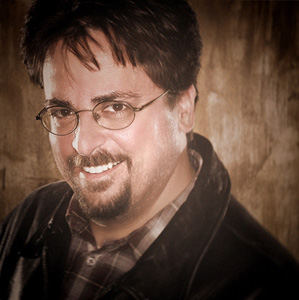
Thanks to Scott and Brad for inviting me to write a post on this blog. It’s an honor to share the stage with so many talented photographers.
On my own blog, I normally write about the nuts and bolts of each photo shoot. For this special post, I’d like to share the key to making a living in this crazy business of photography:
You need to separate yourself from the pack.
But how do you do that? I’ve realized that there are a few things I consistently do when preparing for a shoot.
1) If I see a group of photographers standing together, I run the other direction.
At most of the events I cover, there are a lot of other photographers. The wire services and local newspaper shooters always do a great job covering the event. So what can I bring to the table? If I just shoot the same images as everyone else, there’s no reason for me to be there.
The easiest way to separate myself is to literally move away from the other photographers. I try to take chances and go for the high risk shot. It doesn’t always pay off, but when it does, it’s worth it.
For example, I was assigned to shoot the Live Eight mega-concert in Philadelphia a few years ago. This was a huge international event with performances by Kanye West, Stevie Wonder, Keith Urban, Maroon 5, Jay-Z, and more. There were expecting a million fans.
When I arrived, I saw that there were only two photo positions for the 50-plus credentialed photographers and the spots were way back by the sound board. I don’t like shooting from the back because the pictures just aren’t as dynamic as the shots from the photo pit in front of the stage. More importantly, there were more than 50 photographers all shooting exactly the same thing! I don’t care how big the event is, there’s just no reason for me to shoot the same pictures as everyone else.
It wasn’t going to be easy to break away from the group because the publicists and security guards had made it very clear that we weren’t allowed to shoot anywhere else. I knew I wouldn’t get into the pit in front of the stage, but as fans started to stream in, I noticed that they were giving out wristbands for the front, standing-room section.
I left my 600mm lens with a friend in the back and pretended to be a fan. After seamlessly melding into the line, I managed to snag a wristband! Next thing I knew, I was in the front row pressed up against the barricade and right next to the photo pit. The only thing to do at that point was hide my cameras until the last minute and hope I didn’t get kicked out.
I’m not suggesting that it’s always necessary to break the rules, but in this case, most of the fans in that section had cameras anyway. I shot the entire show from that spot and made pictures that were different from the ones shot in the back.
2) Use technology to my advantage.
I’ve always been an early adopter of technology. I remember beta testing a digital camera at a Chicago Bulls – Miami Heat playoff game in the early 90’s. The files were basically unusable and the camera was nearly impossible to operate. But it gave me a jump on the competition as the tech improved in the following years. I was one of the first full-time digital newspaper photographers in the world. I’d rather struggle with new technology and help the companies make them better than have it forced on me later without any say in the matter.
When I was assigned to photograph President Obama’s inauguration last year, I had to figure out what to focus on (literally) and how to document it.
Of course, this was an historical inauguration so I had to make photos of the swearing in. But I was coming from New York and am not a Washington regular. I knew that the local political shooters would have all the best photo positions. I probably wouldn’t be able to talk my way past Capitol Security and onto the podium to stand next to the first family.
I figured that the other big story was that two million people were going to attend the event. That’s significant. So I researched different ways that I could show the entire crowd.
I had heard of the GigaPan system, but had never used it. The technology was developed by NASA so that the Mars rover could photograph the Martian surface in high resolution. The commercially available GigaPan units were relatively new and had mostly been used for landscape type photos.
Since the GigaPan shoots a series of photos over a period of time, I called the company to ask how well it would work with a group of people who might be moving around. They offered to send me a loaner unit to try at the inauguration. They even loaned me a camera because I don’t own a good point-and-shoot, which is all that the original GigaPan could handle.
It arrived the day before I had to leave for Washington so I didn’t even have a chance to test it. The night before the inauguration, I took it out of the case and read the instructions just to make sure it worked.
On the big day, I set up the imager the way I wanted it, input all the parameters, and let it go. While it worked, I shot “regular” photos with my Nikons and long lenses.
In the evening, after I had transmitted all of my photos, I checked the GigaPan and was pleasantly surprised. The stitching worked while I slept and I uploaded the 1,474 megapixel image to GigaPan.org the next day. The resolution allows you to zoom into the image and see many of the people who attended. An embedded version on my blog and a post on Facebook later, I had over 12 million views. If you Google the generic phrase “inauguration photo,” my site usually comes up as number one.
3) Do something differently.
As I write this, I’m on the road shooting a series of Bon Jovi concerts for my company TourPhotographer.com. It’s a dream gig and I love documenting the show each night.
But while the set list changes every day, photographically it’s pretty much the same thing. Fans can buy prints from the shows, so I have to make the expected shots of Jon and Richie on stage. But I don’t want to make the same images night after night, so I push myself to try different things.
I often use remote cameras for my sports assignments, so I decided to put one up at the concert. I mounted a Nikon D3 and 14-24 mm lens right next to Tico Torres’ drum set, looking out at the crowd. During the show, I triggered the camera with my Pocket Wizard whenever I thought it would make a good image.
Obviously, this is a shot that very few people will ever get to take. But now I’ve got to find yet another way to shoot the show.
4) Give them more than they expect.
It’s not easy to get hired for a shoot. My clients are investing in me and I’d better produce. I try my best to make them want to hire me again.
I like to imagine potential clients in a meeting trying to decide who to hire. They could be saying, “There are a bunch of people who can do this job. Just hire one. If the first photographer is not available, it doesn’t matter. Just hire the next one on the list.”
That’s not the group I want to be in. I prefer that they say, “We’ve got to have Bergman for this one. Give him whatever he wants.”
Of course, it doesn’t often happen like that, but you get my point.
The way you make them remember you is to give them more than they expect.
A number of years ago, Sports Illustrated sent me to cover the NFL draft. Photographically, it’s a difficult event to cover because nothing happens. The player’s name is called, he comes out and shakes hands with the commissioner, and walks off the stage. Traditionally, the pictures are important only for their historical significance but aren’t very memorable.
This is another event where the photographers were all told to stand in one assigned position. Sports Illustrated can get pictures from the wire services so it allowed me to take some chances.
I wandered around before the event and found a balcony that overlooked both the “green room” (the area where they keep the players and families) and the stage area. I thought I might be able to get it all in one shot, so during the draft I went up there for a bit and made some pictures.
The image ran as a two-page spread in Sports Illustrated’s coveted “leading off” section.
Because of that, SI now calls on me to cover the draft every year. Of course, I have to come up with something different each time. One year I set up a portrait booth outside the building to make pictures of fans. Last year, I set up multiple remote cameras all around the stage so that I’d have unique angles that no one else had.
—
There are a LOT of photographers out there. It wasn’t that long ago that most people had trouble simply loading 35mm film. But the camera companies have made it very easy for anyone to properly expose and focus an image.
To make a living as a professional photographer, you’ve got to stand out:
1) If you see a group of photographers standing together, run the other direction.
2) Use technology to your advantage.
3) Do something differently.
4) Give them more than they expect.
Run through that checklist before each shoot, and you’ll be on your way to separating yourself from the pack.
For more from David, check out his website, and keep an eye on TourPhotographer.com for his exclusive concert work.



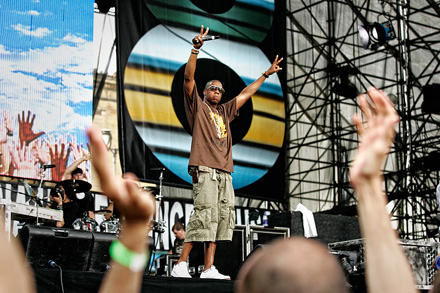
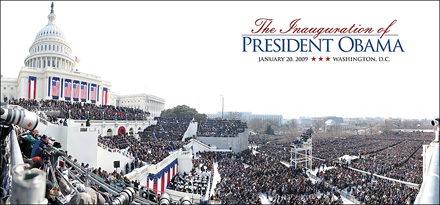
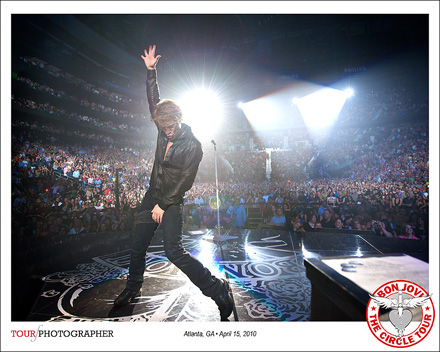
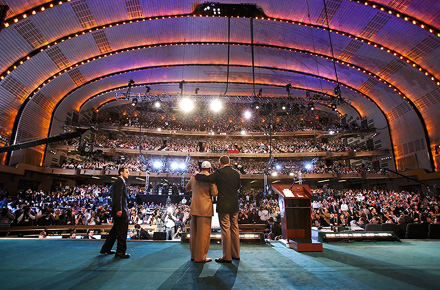
Great post David with a ton of inspiration and insight! Fantastic shooting and words, thank you.
Great Post David, very interesting!! Bravo!!
A real great inspiration!! Thanks a lot for this post!!
Wow, I’m just leaving the house for a days shooting, and this post has really inspired me for the day
Thanks David, and thanks Scott for bringing him here !
I’ve been following David’s blog for a while now. He is an eclectic photographer that spans many genres – much like Scott, sort of….. His work has been inspiring on many levels to me over the last several years, if you get a chance, check out his blog/portfolio to get a flavor of what he has been cooking.
I first stumbled across his site during some football research. I found the most amazing collection of images from Tim Tebow’s 2008 SEC champ game strung into a video sequence shot by Dave. Check it out here.
Then of course came his inaugural Tour de Force.
But more recently his support for the project, Do 1 Thing, to aid the homeless is just moving. Check it out: Do 1 Thing
Not to mention his SI superbowl image of Drew Brees.
Mr. Bergman is living life as a photographer to the fullest and leaving a legacy for others to follow.
Awesome post David! Love your site. You’re a very talented photographer indeed.
What a fantastic post David!
You have given me plenty of food for thought now ;)
I don’t plan to do this for more than a hobby (I’ll starve), but I use #1 all the time. Good suggestions, great blog!
GREAT JOB DAVID!
Certainly will make me think twice on future assignments.
Thanks to Scott & Brad for getting great guest bloggers.
-Bob
Nice post. Very very informative.
Good and important notes to keep in mind and put to use when going for a shoot.
Thanks David. Fantastic post. All I can say is WOW! As someone relatively new to photography, all your points resonate with me, especially # 1.
Now I have another blog to add to my RSS feed.
David , great blog! and I really like your concert site. The shot of Kanye on stage with the clapping hands is a great pose ( I got a similar one with Willie Nelson) and it brings the concert to life. I have been going to concerts since 69 and I have to say my favorite rockin concert group is Bon Jovi, start to finish, no slowin down! I started getting serious about conerts about 2 years ago after i befriended our local auditorium manager (ok, I set that up) and have had an all access pass to every event since. How did you get your start in concert photography? (nice GigaPan too, got to get me one of those)
PS Love that Shake Me video!! Unbelievable from one D3s. Thats some awesome editing also.
Terrific post and wonderful advice, David. Just the kind of advice a “budding pro” like me can benefit from. It’s so easy to fall into the trap of grabbing the “sure thing” shot. I have to make a conscious effort to push myself to think outside the photographer’s box and I know that after reading this blog post, your inspiring tips will find a home in a readily accessible corner in my brain.
Thanks again,
Trev J.
David, one more thing, sorry to blog hog (not really, I do it all the time :) ) how about coming back and doing a video on how you dedited the football video with the 1300 or so photos. That is insanely awesome!!
Exellent post Dave. Your thoughts give a wanna-be pro like me something to think about. I’ve got to hand it to you. Your “being different” really strikes a nerve with me. I’m always trying new things, but haven’t really found anything that I would consider my style yet. But, I will keep trying.
Thanks for the inspiration
Mike
Perfect advice for any photographer – even a learner like me!
David,
I took your advice during the last World Wide PhotoWalk. Unfortunately, it seemed to backfire. I thought I had taken some excellent shots, and provided unique images to the group. Though I am biased, I did not see any images from other people that I felt trumped my shots. Because of my “running away,” I don’t think my images were chosen.
IF I do the PhotoWalk again, I will still run away. I didn’t want to shoot what others were shooting, I didn’t want to walk when they walked, I didn’t want to be distracted by conversations with people I didn’t know (when I could be shooting instead).
While I agree with your advice, this was once instance where it backfired.
David,
nice informative post and so good of you to share your tips for success.
many thanks
Dade
Your gigapan at the new MN Twins Target Field on the Gigapan Website is exceptional too. Great post.
D,
Thoroughly enjoyed your post. Appreciate the insight. Keep doing your thang..
Peace.
-Ade
Great post. Thanks for the advice.
Thank you! Keep up the good work!
Fantastic guest blog. Some great stories and some great advice in there. Fantastic. Thanks for all the insight.
Szabi
Great post Dave.
one way I try seperating my shots from others is forcing myself to shoot stricly with primes which makes me look for diffrent angles and see things diffrently
Enjoyed David’s post immensely and I as a drummer/bassist can relate to taking pictures of friends band although I’m not ready to give up my drums just yet lol thanks for your insights and tips.
Anyone who did’t search David’s web and/or blog should go back and check it out! He has a lot to offer.
This was interesting and the Bon Jovi shot inspires me to try out new angles at concerts. Thank you for the tip!
Hi David,
Great post and photographs!! It’s so funny reading your post here as I received an email yesterday to purchase some of the Bon Jovi concert images. I started looking through the photos to see if there was anything substantial and the image you have posted here is one that I thought was pretty cool and different and I would definitely consider purchasing.
Thanks again!
thanks alot for posting this David. I really like your take on ‘be unique’. Its been known that the secret to stand out is be unique, but nobody really give example as good as you.
Cheers!
RC, Brad K, Dave and Brad M, why don’t you guys have one day where we can all ask you guys questions or opinions? For instance: If I shoot an outdoor portrait and bracket the exposures to use in HDR with cs5’s new Pro HDR filter, then use one of the photos for the anti ghost, would this not look better than doing a PORTRAIT (person) HDR the old way (with more noise and over saturation? Picking the one photo will take car of the person not being able to stay perfectly still. How about it, anyone else think this is a good idea? During the live webinars some of the questions I thought were very good, went unanswered (I know you guys were bombarded with questions). Please :)
Sorry, left out Larry B (and anyone else who can).
Great ideas, clearly put. I really love this series, and as an aspiring photographer I learn a lot. Also, I’m pleased to say I am rarely found in a crowd of other photographers, so I must be doing something right!
Great blog post – thanks.
Totally agree with the 1st point and I’ve done it on occasions – sometimes the acts (DJs in my case) are wuite far back on stage so that the pit gives a very poor angle – so nothing for it than to stash the bag somewhere and jump into the crowd.
Also works if a venue has a “1st 3 songs then your out” policy ;)
Consider your blog followed.
NOTE: Always to remember the photo editors that are in the newsroom hoping you save their asses when you actually pull one of your crazy ideas off!!! xoxo Shelley
Nice job snagging the wristband. I carry wristbands in five different colours in my camera bag. At any large event, it’s usually better to ditch the 600mm and climb into the “mosh pit” with the commoners :)
I’ve saved all of my press passes over the past 30 years. Most likely I have one that looks like VIP pass for my next gig.
But the fake pass/wristband thing only works if you act like you’re supposed to be there.
And don’t make eye contact with the secret service dudes.
I might add a number five to his list… One that I’ve learned from David…
Always be willing to help the little guy.
I met David online a long time ago when I was just getting started. He was always willing to answer my questions and we’ve now had the chance to hang out a few times. He’s an amazing guy who has a lot to share and he’s always been that kind of guy.
Great post David!
Cheers,
Zack
interesting read :) and i’m not even a photographer.
awesome job on inauguration by the way. i was posting CSI nonsense video on facebook (how they zoom in images taken with nokia’s 2 megapixel phone camera) and then friend linked your site as a response saying “that’s what you call hi-tech!” :D